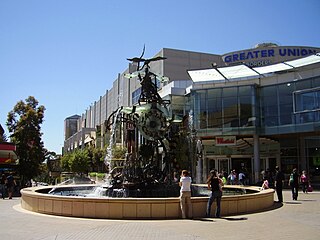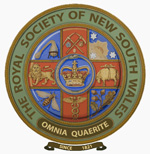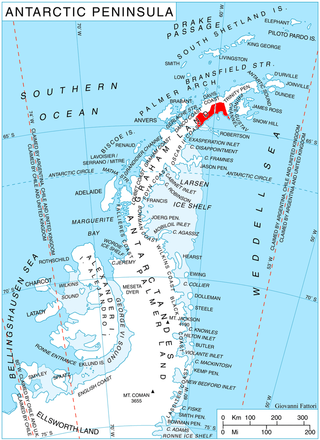
Sir Douglas Mawson OBE FRS FAA was an Australian geologist, Antarctic explorer, and academic. Along with Roald Amundsen, Robert Falcon Scott, and Sir Ernest Shackleton, he was a key expedition leader during the Heroic Age of Antarctic Exploration.

Hornsby is a suburb on the Upper North Shore of Sydney in the state of New South Wales, Australia, approximately 23 kilometres (14 mi) north-west of the Sydney central business district. It is the administrative centre of the local government area of Hornsby Shire.

Margaret Edgeworth David McIntyre, was the first woman elected to the Parliament of Tasmania, representing the seat of Cornwall in the Legislative Council.

The Royal Society of New South Wales is a learned society based in Sydney, Australia. The Governor of New South Wales is the vice-regal patron of the Society. It is the oldest learned society in the Southern Hemisphere.

Sir Tannatt William Edgeworth David was a Welsh Australian geologist and Antarctic explorer. A household name in his lifetime, David's most significant achievements were discovering the major Hunter Valley coalfield in New South Wales and leading the first expedition to reach the South Magnetic Pole. He also served with distinction in World War I.
Bunger Hills, also known as Bunger Lakes or Bunger Oasis, is a coastal range on the Knox Coast in Wilkes Land in Antarctica, consisting of a group of moderately low, rounded coastal hills, overlain by morainic drift and notably ice free throughout the year, lying south of the Highjump Archipelago. The reasoning behind the minute amount of ice in the area is still relatively unknown and remains under intense debate amongst scientists today.

Alistair Forbes Mackay was a Scottish physician, biologist, and polar explorer known for being the first, along with Australians Douglas Mawson and Edgeworth David, to reach the South Magnetic Pole on 16 January 1909, during the British Antarctic Expedition of 1907–1909.
Sir Raymond Edward Priestley was an English geologist and early Antarctic explorer. He was Vice-Chancellor of the University of Birmingham, where he helped found The Raymond Priestley Centre on the shores of Coniston Water in the Lake District National Park.
Don A. Adamson (1931-2002), Macquarie University, was an Australian biologist. He grew up in the Australian bush where he lived his early childhood before moving with his parents to Sydney. He was educated at North Sydney Boys High School and Sydney University in biological sciences where he received his doctorate. He was appointed to a lectureship in the School of Biological Sciences at the then relatively new Macquarie University and was later rewarded with an Associate Professorship and became Senior Research Fellow in biology.
David Island is an ice-covered island, 10 miles (16 km) long and 6 miles (10 km) wide, marked by rock exposures along its north and east sides, lying off Davis Peninsula in the Shackleton Ice Shelf in Antarctica. It was discovered in November 1912 by the Western Base party of the Australasian Antarctic Expedition (AAE) under Douglas Mawson. Mawson named the island for Edgeworth David, a member of the AAE Advisory Committee.

Antarctica is Earth's southernmost and least-populated continent. Situated almost entirely south of the Antarctic Circle and surrounded by the Southern Ocean, it contains the geographic South Pole. Antarctica is the fifth-largest continent, being about 40% larger than Europe, and has an area of 14,200,000 km2 (5,500,000 sq mi). Most of Antarctica is covered by the Antarctic ice sheet, with an average thickness of 1.9 km (1.2 mi).

The Japanese Antarctic Expedition of 1910–12, in the ship Kainan Maru, was the first such expedition by a non-European nation. It was concurrent with two major Antarctic endeavours led respectively by Roald Amundsen and Robert Falcon Scott, and has been relatively overlooked in polar history. After failing to land in its first season, the Japanese expedition's original aim of reaching the South Pole was replaced by less ambitious objectives, and after a more successful second season it returned safely to Japan, without injury or loss of life.

Nobu Shirase was a Japanese army officer and explorer. He led the first Japanese Antarctic Expedition, 1910–12, which reached a southern latitude of 80°5′, and made the first landing on the coast of King Edward VII Land.

Dinsmoor Glacier is a glacier in the Nordenskjöld Coast of Antarctica, named for inventor Charles Dinsmoor. It flows east from the Detroit Plateau, and merges with the Edgeworth Glacier near Mount Elliott before draining into Mundraga Bay.

Bombardier Glacier is a glacier draining southeast from the edge of Detroit Plateau on Nordenskjöld Coast in Graham Land, Antarctica and through a deep trough between Darzalas Peak and Trave Peak to join Edgeworth Glacier and flow into Mundraga Bay. It was mapped from surveys by the Falkland Islands Dependencies Survey (1960–1961), and named by the UK Antarctic Place-Names Committee for Joseph-Armand Bombardier, the Canadian engineer who developed the snowmobile from 1926 to 1937, one of the earliest successful self-propelled over-snow vehicles.

Edgeworth Glacier is a glacier 12 nautical miles (22 km) long, flowing south-southwestwards from the edge of Detroit Plateau below Wolseley Buttress and Paramun Buttress between Trave Peak and Chipev Nunatak into Mundraga Bay west of Sobral Peninsula, on the Nordenskjöld Coast of Graham Land. It was mapped from surveys by the Falkland Islands Dependencies Survey (1960–61), and was named by the UK Antarctic Place-Names Committee for Richard Lovell Edgeworth, the British inventor of the "portable railway," the first track-laying vehicle, in 1770.

The south magnetic pole, also known as the magnetic south pole, is the point on Earth's Southern Hemisphere where the geomagnetic field lines are directed perpendicular to the nominal surface. The Geomagnetic South Pole, a related point, is the south pole of an ideal dipole model of the Earth's magnetic field that most closely fits the Earth's actual magnetic field.
The Edgeworth David Medal is awarded annually by the Royal Society of New South Wales for distinguished contributions by a young scientist under the age of 35 years for work done predominantly in Australia or which contributed to the advancement of Australian science.
Mark Stephen Harvey is a museum scientist and biologist. Since 1989 he has been based at the Western Australian Museum.













